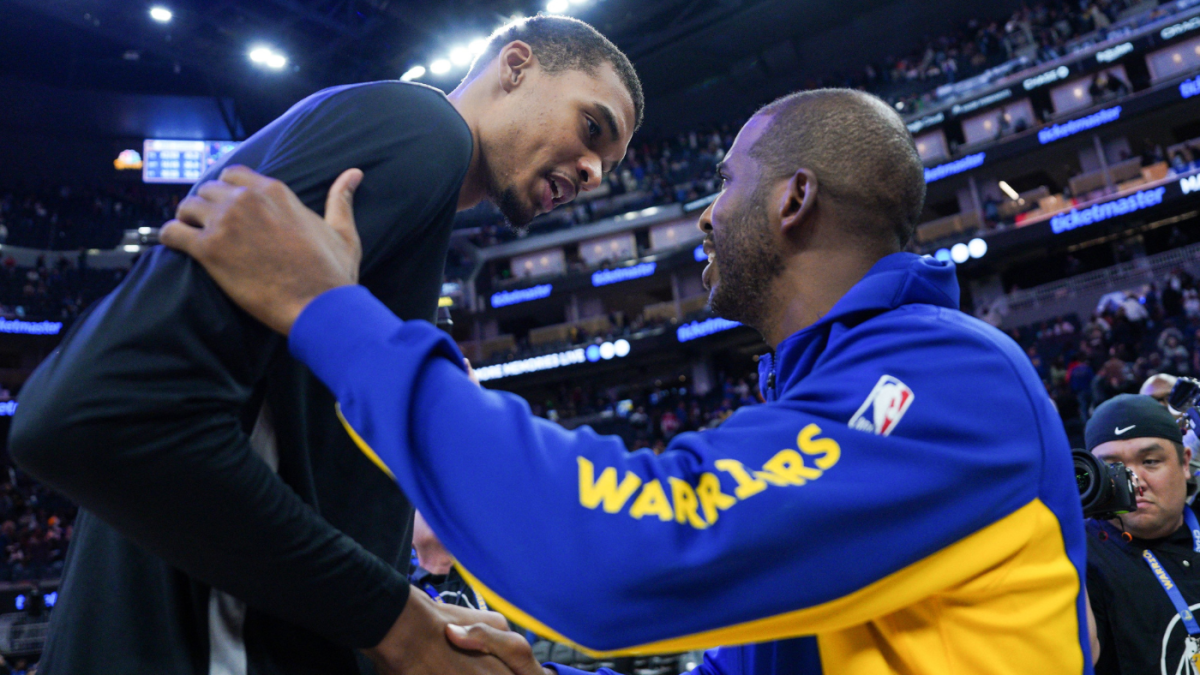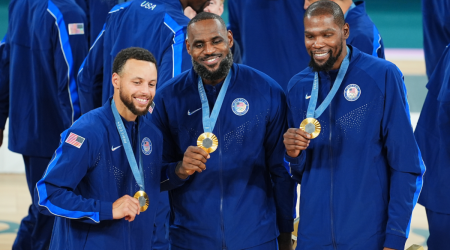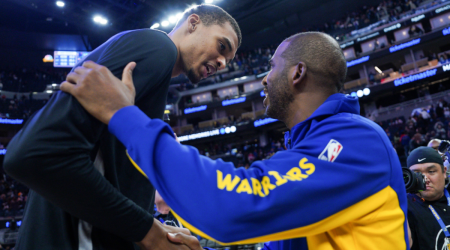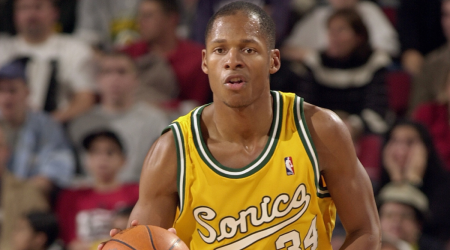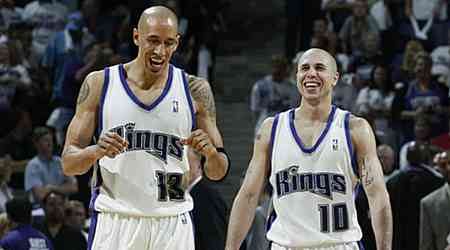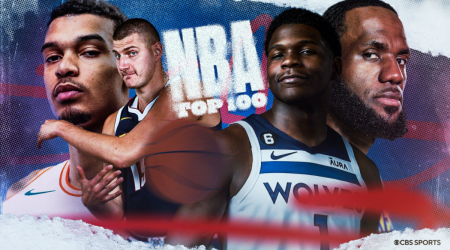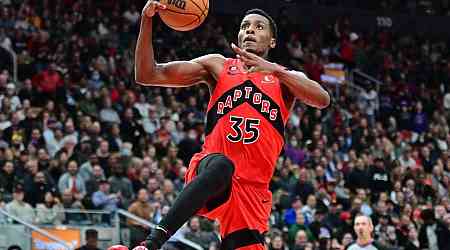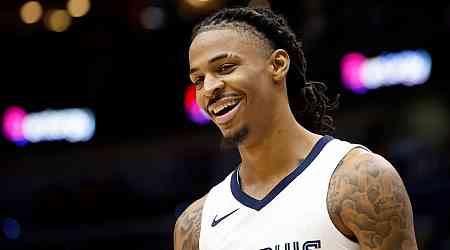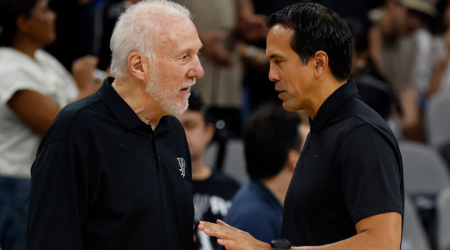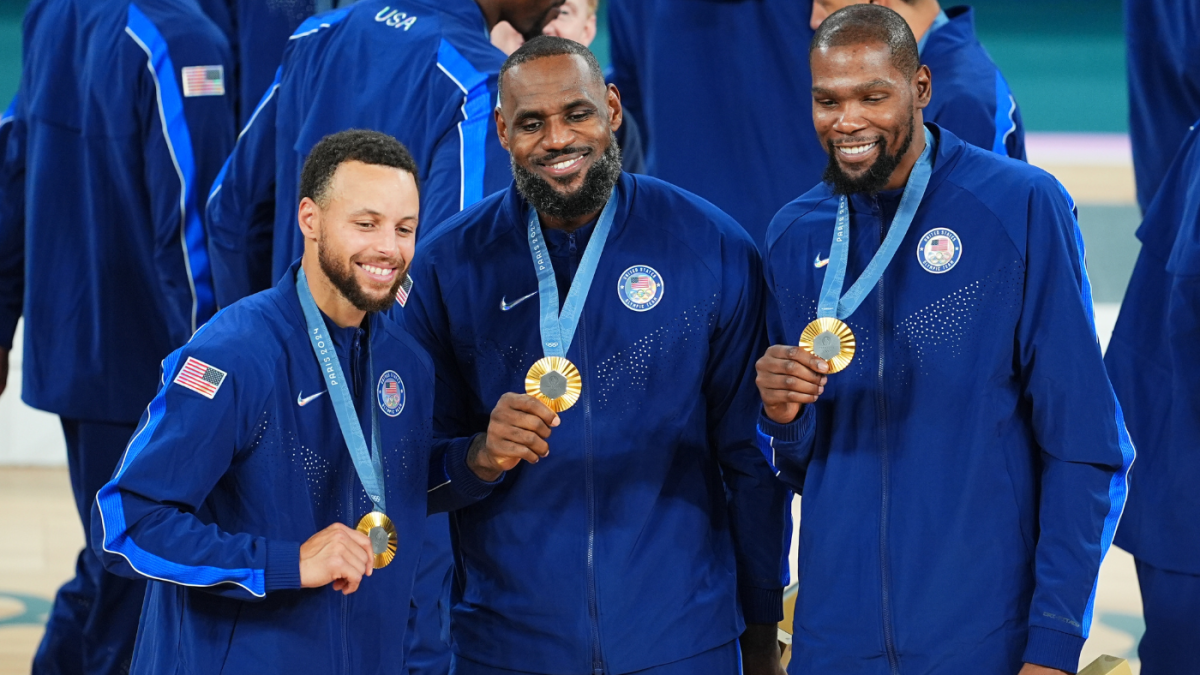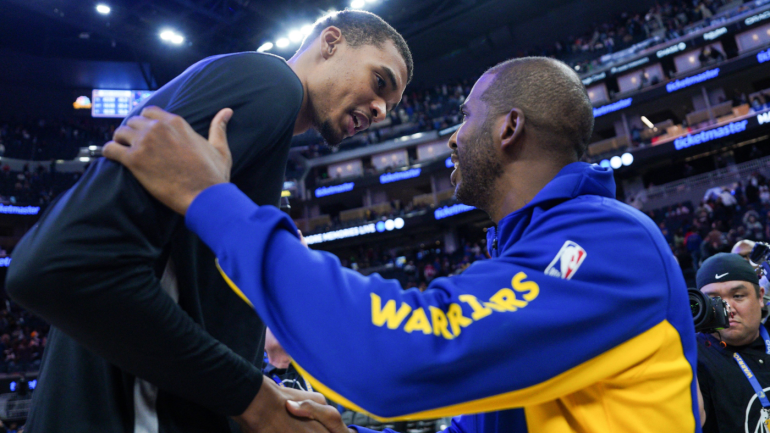
Our annual Top 100 NBA player rankings has become an tradition here at CBS Sports. The 2024-25 version of the list went live on Tuesday morning.
One of the most interesting parts of the process is looking back at last year's rankings and seeing which players moved the most in either direction. That's what we're breaking out here: The 10 biggest risers and fallers from the 2023-24 list to the 2024-25 list.
Reminder, these rankings reflect an aggregate projection of how players will perform this upcoming season. There's some educated guesswork involved. We're not just looking at last season and ranking on known quantities. Rookies are eligible for the list, though none made the cut this year.
Last year, three rookies made the list: Victor Wembanayma, Chet Holmgren and Scoot Henderson. Two of them were sensational in their first NBA campaign and we collectively project both Wembanyama and Holmgren to be significantly better in Year 2 -- as reflected by the combined 84 spots they jumped on this year's list. With that in mind, let's get to the 10 biggest risers and fallers from last season to this season.
Looking for more analysis of CBS Sports' Top 100 list? Listen and subscribe to the Beyond the Arc podcast for breakdowns, debates and more.
Biggest risers
1. Victor Wembanyama: +46 (58 to 12)
Wembanyama catapults 46 spots to just outside the top 10, and for good reason: After the All-Star break, Wembanyama averaged 23.5 points, 12 rebounds, 5.3 assists, 4.5 blocks and 1.5 steals per game. I can't imagine you'll be surprised to hear no one has ever done that for a full season. No one has even come close. If you trim every one of those numbers by 10%, it's still only been done once... by peak Kareem Abdul-Jabbar.
As a reminder, Wembanyama was a rookie. He was playing on a team that was built to lose. We're not just talking about the next great NBA player here. We're talking about the sort of player this sport has never seen, the next step in its evolution. He is the ultimate marriage of size and skill, the culmination of everything this sport has been building towards for the past decade. What's scariest about that absurd post-break stat line isn't how great it is, but how underwhelming it's going to look in comparison. In all likelihood, that's the worst he's going to be for a long, long time. It might be 15 years before we post another one of these lists that has him outside of the top 10. -- Sam Quinn
T2. Chet Holmgren, Thunder: +38 (68 to 30)
The delayed debut for Holmgren, who jumps 38 spots on this year's top 100, was well worth the wait, as he fit seamlessly into an Oklahoma City team built for sustained success through at least the next decade. He's 7-foot-1 and yet has the handle of a guard. He can drain a 3-pointer just as simple as he can back someone down in the paint. He has already established himself as one of the best rim protectors in the league, with a knack for perfectly timing blocks, something we rarely see out of players his age. Holmgren is on a career trajectory to be a mainstay at the All-Star Game, as well as a frequenter of end-of-season awards ballots like All-NBA and All-Defense. -- Jasmyn Wimbish
T2. Alperen Sengun, Rockets +38 (85 to 47)
Sengun matches Holmgren's 38-spot leap into the top 50. His breakout season was cut short, but he still did enough to finish third for Most Improved Player. Sengun is often compared to Nikola Jokic, primarily because his court vision and passing echo that of the three-time MVP. But he's his own player, one that Houston should see as a building block for its future. Sengun's strength and finesse around the rim make it difficult to defend him when he catches the ball on the move. He's also a great rebounder and puts teammates in the right spot for easy shots. Statistically speaking, his first three years are on par with what Jokic did, and while he may not be on the perennial MVP trajectory, it's always a positive when you're mentioned in the same company as a future Hall of Famer. -- Jasmyn Wimbish
4. Tyrese Maxey, 76ers: +36 (60 to 24)
After James Harden's departure, Maxey stepped into the No. 2 role in Philadelphia last season and made the leap from exciting young prospect to All-Star. For his efforts, he was rewarded with the Most Improved Player award. It will be interesting to see how Maxey's role changes, if at all, with Paul George's arrival. The great news for the Sixers is he has the on-and-off-ball skills to easily scale up and down depending on the situation. In fact, he may even be best as a slightly overqualified No. 3 option given his elite catch-and-shoot numbers (44.4% last season). -- Jack Maloney
5. Brandon Miller, Hornets: +35 (NR to 66)
Miller didn't crack our top 100 coming into his rookie season, and all he did was average 17 PPG on 37% 3-point shooting. Miller doesn't turn 22 until November, and he showed as a rookie that he was ready for everything the Hornets threw at him. He often guarded the opposing team's top perimeter player, and, with LaMelo Ball out for most of the season and Terry Rozier traded in January, he often functioned as Charlotte's primary playmaker. The 6-foot-7 wing profiles as a franchise cornerstone, a guy who can create for himself and others and credibly defend multiple positions. -- James Herbert
6. Jalen Suggs, Magic: +31 (NR to 70)
Good things come to those who wait. Jalen Suggs was almost unplayable offensively when he got to the NBA. Emphasis on "almost," because Suggs was so dang pesky on defense that no number of missed 3-pointers could keep him off of the floor. Those reps paid off for him last year, because his 3-point shot hovered around 40% without any decline defensively (in fact, he was better there too). The Magic probably have to make peace with what Suggs isn't at this point. The hope that he could grow into a primary ball-handler on offense that partially informed his draft position has likely faded. But if he's going to be among the NBA's best perimeter defenders and a knockdown 3-point shooter, that alone is more than enough to warrant inclusion on this list. He's a shooting guard, not a point guard, and once the Magic fully embraced that, he turned into the player he was always meant to be. -- Sam Quinn
7. Coby White, Bulls: +30 (NR to 71)
If it hadn't been for Tyrese Maxey's All-Star season, White should've walked away with the Most Improved Player award. This is a guy who, just two seasons ago, averaged 9.7 points off the bench while seeing the fewest minutes of his five-year career. But White earned Chicago's starting point guard spot at training camp and averaged nearly 20 points on efficient shooting numbers. He's explosive when he drives to the rim, can fill it up from outside and has improved as a passer and rebounder. -- Jasmyn Wimbish
8. Jalen Williams, Thunder: +28 (65 to 37)
Here's a fun statistical comparison of two players' 2023-24 seasons:
- Player A: 34.8 points, 6.5 assists and 4.2 turnovers per 100 possessions; 56.7% 2P%, 41.3% 3P%, 62.6% TS%, 28.3% USG%
- Player B: 34.8 points, 8.4 assists and 3.7 turnovers per 100 possessions; 56.8% 2P%, 41.6% 3P%, 60.7% TS%, 29.3% USG%
The first player is Kevin Durant. The second player is Williams in the 828 minutes he played without Shai Gilgeous-Alexander on the court. This is not to say that the 23-year-old Williams is a superstar hiding in plain sight, necessarily – part of superstardom is being able to get your numbers consistently despite being at the top of opponents' scouting report and being hounded by opponents' best defenders, not just as the No. 2 guy and against second units – but, I mean, sheesh. If Williams' relative struggles against the Mavericks in the playoffs give him a roadmap for offseason improvement, watch out. This guy is already a scorer from all three levels, a knockdown shooter, a clever playmaker and a versatile defender. There are All-Star appearances in his future. -- James Herbert
9. Isaiah Hartenstein, Thunder: +28 (NR to 73)
The obvious appeal of Hartenstein for Oklahoma City is his sheer bulk. Dereck Lively bullied the Thunder out of the playoffs last spring. That's not happening on Hartenstein's watch. He's a defensive metrics darling—D-EPM rated him the second-best defender in basketball last season behind only Jonathan Isaac—who will hold his own on the glass and is comfortable starting or coming off of the bench. But the secret sauce here is that unstoppable push shot from floater range. The Thunder quietly ran into shot-creation issues against Dallas. When the 3's aren't falling and the shot-clock is nearing zeros, it is really, really valuable to just be able to dump the ball on a big man that can consistently score outside of the dunker's spot. -- Sam Quinn
10. Derrick White, Celtics: +26 (62 to 36)
Two years ago, White wasn't even on our list. Now, he checks in among the top 40. More exposure from playing with the Celtics certainly helps, but White ranks this high because he has turned himself into the ultimate role player. He does whatever the Celtics need from night-to-night on both ends of the floor, and was so impressive during the title run that he earned a spot on Team USA. Here's a stat to emphasize his versatility: Last season he joined Larry Bird and Kevin Durant as the only players ever to average at least five assists and one block per game, while shooting 39% from 3-point range in a season. -- Jack Maloney
Biggest fallers
1. Andrew Wiggins, Warriors: -53 (48 to NR)
Wiggins has fallen off considerably since he was an All-Star in 2021-22 and probably the second-best player on the Warriors' 2022 title team. His father, former NBA player Mitchell Wiggins, recently died, and Andrew had taken multiple leaves of absence the past two years as his father's health was in decline. If Wiggins can get back to something closer to his 2022 form on the court, he can still be a top-100 player by season's end. -- Brad Botkin
2. Josh Giddey, Bulls: -40 (61 to NR)
I don't know about this one. If you watched Giddey in the Olympics and/or during random stretches with the Thunder when circumstances allowed, you know that he is an entirely different and pretty damn good player with the ball in his hands. He should get that chance in Chicago. I get it .. Coby White and Zach LaVine are going to possess the ball a lot, but White is a possibility to get traded before he hit hits free agency and Chicago would gladly jettison LaVine if anyone would take him. A few things have to fall into place, but Giddey could easily have a top-100 season. -- Brad Botkin
3. Brook Lopez, Bucks: -38 (50 to 88)
How often do you hear a fanbase lament its lack of a rim-protecting center that can shoot 3-pointers? The Pelicans have been looking for one for five years. Everyone wants a Brook Lopez. They can't have one because he's one of a kind. Short of superstars on max contracts, there simply aren't other centers who take nothing off of the floor on either end while adding quite a bit on both. Lopez leads the league in contested shots every year. The 3-point efficiency waxes and wanes, but he pairs it with enough craft inside of the arc that defenses still have to account for him no matter where he is. He doesn't pull in rebounds himself, but he's so smart in his positioning and boxing out that he's a very valuable team rebounder. He's the center everyone wants but only the Bucks get to have, even if he tumbled down our Top 100 list as he enters his age-36 season. -- Sam Quinn
4. Marcus Smart, Grizzlies: (-37) 56 to 93
Smart took a big tumble down this list, though that's more to do with injury than anything else. He was limited to 20 games last season, the fewest of his career, because of ankle and finger issues. Now healthy, he should reclaim his place as one of the best perimeter defenders in the league. He'll be one of many Grizzlies making their return this season, and figures to play a big role in their quest to contend in the Western Conference. -- Jack Maloney
5. Zach LaVine, Bulls: -37 (43 to 76)
We only saw LaVine for 25 games last season as he underwent season-ending foot surgery. But when he was healthy, he was among the most efficient scorers in the league. He can make you pay from all three levels but is most dangerous when filling it up from mid-range or attacking the rim. The Bulls were expected to trade him, but he's back in Chicago with three years and nearly $140 million remaining on his contract after nothing came to fruition. -- Jasmyn Wimbish
6. Klay Thompson, Mavericks: -32 (67 to 99)
Even in a down year, Thompson still managed to be one of the best 3-point shooters in the league while averaging 18 points a night. But his efficiency has steadily faltered since a return from a two-year, injury-laden absence. He was once an All-Star mainstay, one of the best 3-and-D players money could buy, and capable of lighting you up if he saw a couple of triples go down. And after 11 seasons and four championships with the Warriors, Thompson starts a new chapter in Dallas. Perhaps it will be a much-needed fresh start for one of the best sharpshooters in the history of the NBA -- Jasmyn Wimbish
7. Bradley Beal, Suns: -31 (38 to 69)
There was great debate regarding Phoenix's decision to trade for Beal, given his injury history, inability to credibly defend, and overlap in position between him and Devin Booker. Those are all valid concerns, but Beal did have his most efficient season ever last year on a team that won 49 games. He missed 29 of them, but his performance when he was healthy makes you wonder how much better the Suns would've been had he been available more often. Beal is a threat from beyond the arc, can score on or off the ball and does enough of the little things to make him a quality starter on a contending team. -- Jasmyn Wimbish
8. Chris Paul, Spurs: -28 (73 to NR)
Paul's decline continued to accelerate last season with the Warriors to the point that we're finally comfortable ranking one of the best points guards in history outside our current top 100 NBA players. Having said that, Paul can still help a team -- particularly the San Antonio Spurs, who picked him up with the idea that he can nurture the growth of Victor Wembanyama with mere competent on-court play and a wealth of knowledge in his ear. -- Brad Botkin
9. Malcolm Brogdon, Wizards: -28 (73 to NR)
Just too many unknowns to project Brogdon inside the top 100. Is he healthy? Can she stay healthy? Will the Wizards flip him? If he's healthy, probably. If he's not, he's a compromised version of himself playing for ... the Wizards. That's if he's playing at all. Brogdon is a good player but not a top-100 guy under these conditions. -- Brad Botkin
10. Draymond Green, Warriors: -26 (30 to 56)
One of the quintessential "he's not what he used to be" players, Green remains a conductor on both ends. He can still guard any position and make impromptu defensive plays in the way Stephen Curry navigates the offensive end of the court on sixth-sense instincts. Quietly, Green shot nearly 40% from 3 last season on over two attempts a game. He knows he needs to be a threat and last season he more aggressively attacked the scoring runways defenses were all to happy to lay out for him. -- Brad Botkin


















